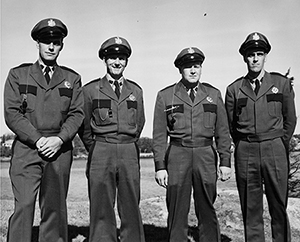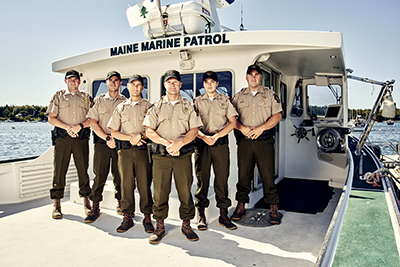 |
 |
1880s -
The Maine Marine Patrol is the oldest law enforcement organization in the State of Maine. Its roots can be traced to 1867, when the legislature authorized two Fisheries Commissioners who were charged with the conservation of the state's sea-run fish species.
In 1885, Sea and Shore Fisheries Commissioner was established, and newly designated "Fish Wardens" were given the responsibility of overseeing all coastal and riverine fisheries.
1900s -
In 1903, the Commissioner of sea and shore fisheries was authorized and empowered by the legislature to purchase the State’s first vessel in support of the newly enacted legislation for the protection of lobsters with eggs attached – the equivalent to today’s “Seed Lobster Program”. The legislative act not only funded the purchase of egged lobsters for the purpose of either liberating them to the sea or selling them to the United States fish hatchery, but also funded the purchase of a vessel, a naphtha powered launch named “Sea Gull”, to support collection of the lobsters with eggs from along the coast.
1930s -
The Sea and Shore Fisheries Commissioner was changed to the Department of Sea and Shore Fisheries in 1931. In 1938, the first large 60-foot patrol vessel was purchased, allowing the Department to operate in summer and winter. She maintained a coastal presence all winter and came in handy in breaking ice and towing disabled fishing boats to port.
1940s -
In 1947, the title of "Fish Warden" was changed to "Coastal Warden," which stayed the same until 1972 when the Department of Sea and Shore Fisheries became the Department of Marine Resources. That same year the Department purchased two motorcycles for Wardens and also had two patrol boats, the 53-foot diesel-powered "Maine" and the 28-foot diesel-powered "Lively Lady." Wardens were also authorized to hire private boats for special situations.
1950s -
In the 1950s, the Department maintained a small fleet of vessels which included the 42-foot "Explorer" stationed in Boothbay, the 26-foot "Hel-Cat" stationed in Jonesport, the 26-foot "Little Explorer" stationed in Southwest Harbor, and the 34-foot Guardian stationed in Rockland.
1953 saw the addition of three investigators to the workforce as well the first pilot who flew the Coastal Wardens' first airplane, leased from another state agency.
1960s -
A new Cessna 180 Float Plane was added to the service in 1961. The same year officers began to get scuba training, and some were issued dive gear.
In the mid-sixties, many new provisions of law were added to the Warden’s responsibility, including littering, watercraft registrations, new lobster closed periods, and buoy displays.
1970s -
A state government re-organization in 1973 again changed the Department’s name from The Department of Sea and Shore Fisheries to The Department of Marine Resources and changed the Coastal Warden’s designation to Marine Patrol Officer. The mid-1970's also saw the addition of an 83' combination research-enforcement vessel "Challenge" and the establishment of two 44' patrol boats, the "Maine" and the "Guardian".
1980s -
In 1988, the first formal Field Officer Training Program was launched, allowing new Marine Patrol Officers to receive training during a probationary period.
In the late 80s Marine Patrol began building a fleet of vessels, and eventually each of six sections would have a large lobster style boats in the 35-foot class.
The Bureau, after having transitioned through several aircraft over previous decades, upgraded its aircraft to a used 1983 Cessna A185F in 1989.
1990s -
In the early nineties shotguns were phased out and long guns were introduced. Digital cameras, pagers and cell phones were also issued to Patrol. Officers also began to be issued four-wheel drive pick-up trucks for patrol work.
In 1995 Marine Patrol and Maine State Police collaborated to form a joint Underwater Recovery (Dive) Team capable of leveraging resources and personnel from both agencies.
The new class of high-speed 35-foot patrol boats began being launched. The "Winds" and the "Sentinel" along with the 44-foot "Guardian" and were added to the fleet. These lobster style boats were high-performance, diesel-powered and capable of 20 plus knots. All were equipped with the latest in electronic aids to navigation and provide year-round, all-weather capability.
2000s -
In the aftermath of 9/11, Marine Patrol formed a Maritime Security Team partnering with the State Police Tactical Team. The role of this highly trained team was to address any high-profile tactical needs within the State’s Territorial Waters.
In 2002, the Bureau of Marine Patrol entered into the first Joint Enforcement Agreement with NOAA’s National Marine Fisheries Service. The JEA formalized an agreement between the agencies for Marine Patrol Officers to perform concurrent Federal fisheries enforcement work.
Also in 2002, the “Guardian III” was launched. This vessel was a 46-foot Wesmac lobster boat custom built for the agency. The “Guardian III” was powered by a 1300HP MAN diesel engine and was capable of approximately 30 knots and was the first of several 40+ foot patrol boats to be built to replace the Bureau’s smaller 35-foot vessels.
2010s -
Marine Patrol Officers began using laptops in their trucks to access records management systems and dispatch information capable of sharing information among multiple law enforcement agencies.
The Department of Marine Resources main office and Marine Patrol headquarters moved from Hallowell to Augusta.
In 2016, seven Maine Marine Patrol Officers were recognized by the Maine Legislature for saving a life while on duty. Both the House and Senate passed a Joint Resolution honoring them for the importance of their profession, the knowledge and skill their job demands, and for putting their own lives at risk to save the lives of others.
2020s -
In 2021 Marine Patrol began to replace an aging fleet of 21-foot Justine model Whalers with new 23-foot Silver Ship Ambar patrol boats. These new vessel platforms were the agency’s first primary patrol boats fabricated from aluminum. Also in 2021, the Bureau launched a new 42-foot patrol vessel, “Endeavor”, replacing the 20+ year old 35-foot “Monitor”.
Marine Patrol Officers today are highly trained conservation law enforcement officers with a multitude of tools and skill sets. Officers have assigned patrols and are on call 24/7. They are expected to work either on their own or as crew on the larger vessels, work in close cooperation with fishermen, focus on resource work, and bring marine resource violators to justice.